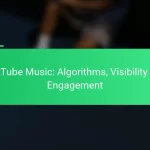To effectively grow your audience on Twitter, it’s essential to create engaging content, leverage targeted advertising, and actively engage with the community. A strong content strategy should focus on shareable visuals and relevant insights that resonate with your audience. Additionally, understanding the best times to post based on your audience’s habits can significantly enhance engagement and interaction.

How to Grow Your Audience on Twitter?
To grow your audience on Twitter, focus on creating engaging content, utilizing targeted advertising, and actively participating in the community. Consistency and strategic interactions are key to attracting and retaining followers.
Utilize Twitter Ads for Targeted Reach
Twitter Ads can significantly enhance your reach by targeting specific demographics, interests, and behaviors. Start by defining your audience based on factors like age, location, and interests to ensure your ads are seen by the right people.
Consider using promoted tweets or accounts to increase visibility. Set a budget that aligns with your goals, and monitor the performance of your ads to optimize your strategy over time.
Engage with Influencers in Your Niche
Connecting with influencers can help you tap into their established audiences. Identify key influencers in your niche and engage with their content by liking, retweeting, or commenting thoughtfully.
Building relationships with these individuals can lead to collaborations or shout-outs, which can introduce your profile to a broader audience. Ensure your interactions are genuine to foster authentic connections.
Participate in Twitter Chats
Twitter chats are organized discussions around specific topics, often using a designated hashtag. Participating in these chats can help you connect with like-minded individuals and showcase your expertise.
To find relevant chats, search for hashtags related to your industry or interests. Prepare by familiarizing yourself with the topic and contributing valuable insights during the discussion to attract new followers.
Optimize Your Profile for Discoverability
Your Twitter profile should clearly convey who you are and what you offer. Use a professional profile picture and a compelling bio that includes relevant keywords to enhance discoverability.
Incorporate a link to your website or a landing page in your profile. Regularly update your profile to reflect any changes in your focus or offerings, ensuring it remains relevant to potential followers.
Leverage Hashtags Effectively
Hashtags increase the visibility of your tweets by categorizing them for users searching for specific topics. Use a mix of trending and niche hashtags to reach a broader audience while still targeting your specific community.
Aim for 1-3 hashtags per tweet to avoid clutter. Research popular hashtags in your industry and consider creating a unique hashtag for your brand to encourage user-generated content and engagement.

What Content Strategy Works Best for Twitter?
The most effective content strategy for Twitter focuses on creating engaging, shareable content that resonates with your audience. This includes using visuals, encouraging user participation, and sharing relevant industry insights to foster interaction and growth.
Create Shareable Visual Content
Visual content is crucial on Twitter, as tweets with images or videos tend to receive higher engagement rates. Aim for eye-catching graphics, infographics, or short videos that convey your message quickly and clearly.
Consider using tools like Canva or Adobe Spark to create professional-looking visuals. Keep your visuals consistent with your brand’s style to enhance recognition and shareability.
Post User-Generated Content
User-generated content (UGC) can significantly boost your Twitter presence by showcasing your community and encouraging interaction. Share posts from your followers that highlight their experiences with your brand, products, or services.
Encourage UGC by running contests or campaigns that invite users to share their content using a specific hashtag. This not only increases engagement but also builds a sense of community around your brand.
Utilize Twitter Polls for Engagement
Twitter polls are an excellent way to engage your audience and gather feedback. They allow you to ask questions and receive instant responses, making your followers feel involved and valued.
Keep polls simple and relevant to your audience’s interests. Aim for questions that spark conversation or provide insights into your followers’ preferences, which can inform your future content strategy.
Share Industry News and Insights
Sharing timely industry news and insights positions your brand as a thought leader and keeps your audience informed. Curate content from reputable sources and add your perspective to foster discussion.
Regularly posting updates about trends, research findings, or significant events in your industry can attract followers who value your expertise. Use relevant hashtags to increase visibility and reach a broader audience.

When is the Best Time to Post on Twitter?
The best time to post on Twitter varies based on your audience’s habits and time zones. Generally, weekdays during mid-morning to early afternoon see higher engagement rates, but analyzing your specific audience is crucial for optimal results.
Analyze Audience Activity with Twitter Analytics
Twitter Analytics provides valuable insights into when your followers are most active. By examining engagement metrics, you can identify peak activity times, which helps tailor your posting schedule to align with audience behavior.
Look for patterns in your analytics data, such as days of the week or specific hours when interactions spike. This information can guide your content strategy and improve overall engagement.
Test Different Posting Times for Engagement
Experimenting with various posting times can reveal the most effective slots for your content. Start by scheduling tweets at different times throughout the day and monitor engagement rates over a few weeks.
Consider using A/B testing to compare the performance of posts made at different times. This approach allows you to refine your strategy based on real-time feedback and adjust accordingly.
Consider Time Zones of Your Target Audience
Understanding the time zones of your target audience is essential for maximizing engagement. If your followers are spread across multiple regions, schedule posts to accommodate their local times.
For example, if you have a significant audience in both Europe and North America, consider posting at times that overlap, such as late morning in Europe, which may also be early morning in North America. This strategy ensures your content reaches the widest audience possible.

What Metrics Should You Track for Twitter Engagement?
To effectively measure Twitter engagement, focus on tracking follower growth rate, engagement rates on tweets, and click-through rates on links. These metrics provide insights into how well your content resonates with your audience and help refine your strategy for better results.
Monitor Follower Growth Rate
Follower growth rate indicates how quickly your audience is expanding. Calculate this by taking the number of new followers gained over a specific period and dividing it by your total followers at the start of that period, then multiplying by 100 to get a percentage.
A healthy growth rate typically ranges from 1% to 5% monthly, depending on your niche and activity level. Regularly monitoring this metric helps you identify trends and the effectiveness of your promotional efforts.
Track Engagement Rates on Tweets
Engagement rates reflect how users interact with your tweets, including likes, retweets, and replies. To calculate the engagement rate, divide the total engagements by the total impressions and multiply by 100.
Engagement rates can vary widely, but aiming for a rate above 1% is generally considered good. Focus on creating compelling content that encourages interaction, such as asking questions or sharing polls, to boost this metric.
Analyze Click-Through Rates on Links
Click-through rates (CTR) measure how often users click on links in your tweets compared to how many times the tweet was viewed. To calculate CTR, divide the number of clicks by the total impressions and multiply by 100.
A CTR of 1% to 3% is a reasonable target for most Twitter accounts. To enhance your CTR, use clear calls to action and ensure that your links lead to valuable content that aligns with your audience’s interests.

How to Leverage Twitter for Affiliate Marketing?
To effectively leverage Twitter for affiliate marketing, focus on building a targeted audience, sharing valuable content, and engaging at optimal times. This approach can significantly enhance your reach and conversion rates.
Share Affiliate Links in Tweets
Sharing affiliate links in your tweets is a direct way to promote products and earn commissions. Ensure that your links are relevant to your audience and provide value, as this encourages clicks and conversions.
When posting affiliate links, consider using URL shorteners to make them more visually appealing and trackable. Aim to include a brief description or a compelling call-to-action to entice your followers to click on the link.
Be mindful of Twitter’s guidelines regarding affiliate links. Avoid excessive promotion, as it can lead to account suspension. A balanced approach, integrating links within engaging content, will help maintain audience interest.


